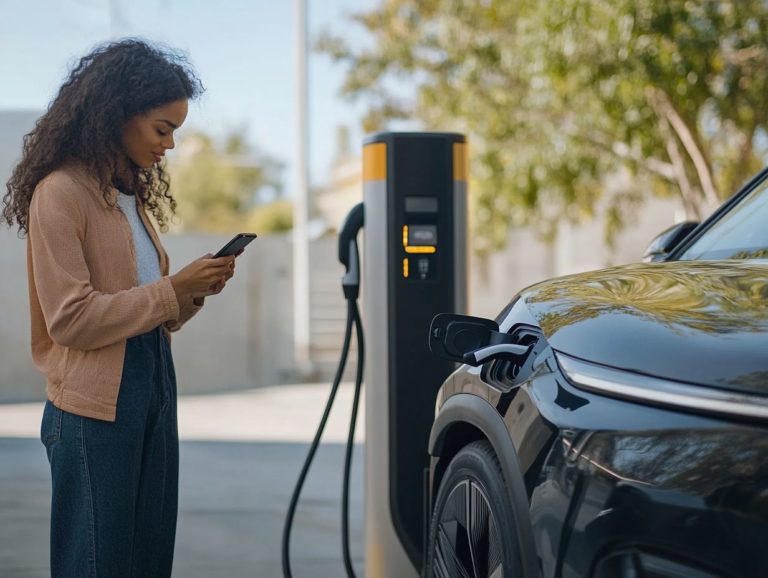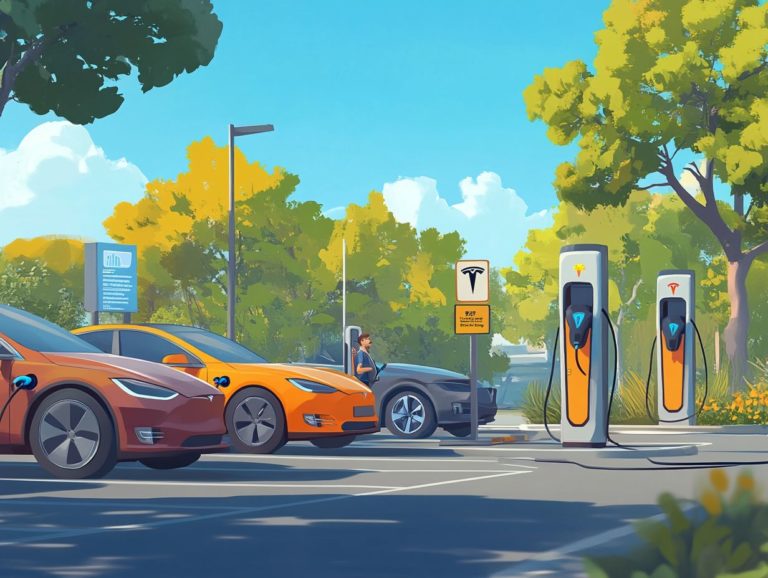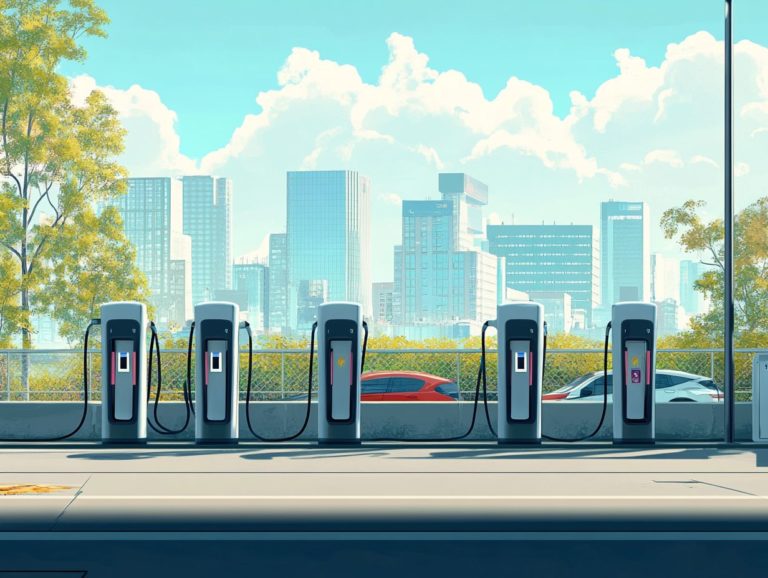5 Emerging Charging Technologies to Watch
Charging technology is evolving rapidly. New innovations make it easier and more convenient to power your devices.
Imagine a world where wireless charging frees you from tangled cords, or where solar charging harnesses the sun’s energy to power your gadgets. These innovations are transforming how we connect and energize our devices.
This article will explore five emerging charging technologies wireless, fast, solar, inductive, and magnetic resonance. We’ll look at how they work, their benefits, limitations, and real-world applications.
Step into the future of charging with us as we delve into the ethical considerations that accompany these advancements.
Contents
Key Takeaways:

- Wireless charging offers convenience and eliminates the need for cords.
- Fast charging technology allows rapid device charging, saving you time.
- Solar charging uses the sun s power, reducing reliance on traditional electricity.
1. Wireless Charging
Wireless charging technology is revolutionizing the electric vehicle (EV) market. It provides convenient and efficient charging solutions that enhance your experience and support the adoption of electric vehicles.
This innovative system uses inductive charging, a method that uses magnetic fields to transfer energy. You can charge your vehicle without any physical connectors, minimizing wear and tear.
As electric vehicle adoption grows, companies like GoCharge Tech are pioneering groundbreaking wireless solutions. Their goal? To foster a sustainable future powered by renewable energy.
By eliminating cumbersome cables, this technology reduces clutter and opens doors to more frequent charging opportunities. This is essential as urban areas enhance their infrastructure to support cleaner transportation options.
The simplicity of wireless charging encourages you to make the switch to electric vehicles, helping to lower carbon emissions. GoCharge Tech is integrating smart features into their systems, ensuring that reliable charging solutions are always available.
2. Fast Charging
Fast charging technology is a remarkable leap forward in the EV market. It significantly cuts the time you spend recharging lithium-ion batteries, enhancing your overall experience at charging stations.
This innovation includes ultra-fast charging stations that can provide substantial charges in mere minutes. As you become more aware of the fear of running out of battery on long trips known as range anxiety these rapid charging options are essential for the widespread adoption of electric vehicles.
Companies like GoCharge Tech lead the charge in this evolution, investing heavily in advanced infrastructure that supports swift charging capabilities. Their efforts build consumer confidence and establish dependable frameworks for electric mobility, contributing positively to sustainable transportation.
3. Solar Charging
Solar charging is revolutionizing the electric vehicle (EV) charging landscape. It utilizes renewable energy to power the growing fleet of electric vehicles, championing a sustainable future.
By integrating solar power into charging stations, you reduce your carbon footprint and reliance on fossil fuels, contributing to a cleaner environment. Companies like GoCharge Tech are at the forefront, merging innovative solar technology with EV solutions.
These solar charging stations harness the sun’s energy, allowing you to charge your vehicle without tapping into the grid. More cities and communities are adopting similar eco-friendly charging options, widening the reach of renewable energy.
Join the charge towards a sustainable future! Explore these technologies and make a difference today!
4. Inductive Charging

Inductive charging is a revolutionary technology that allows electric vehicles to charge wirelessly. This innovation provides a seamless user experience and boosts the efficiency of charging infrastructure.
This method uses electromagnetic fields to transfer energy from a charging pad to a receiver on your vehicle. Say goodbye to cumbersome cables!
Simply park over a charging station, and your vehicle starts charging automatically. This system is incredibly convenient and saves you the hassle of plugging in.
As electric vehicles (EVs) grow in popularity, inductive charging solutions can transform charging stations into smarter, user-friendly zones. Current implementations are seen in parking garages and select governmental fleets, with great potential for transit systems and personal EVs soon.
5. Magnetic Resonance Charging
Magnetic resonance charging is an exciting evolution of inductive charging. It offers improved flexibility and efficiency for electric vehicles (EVs).
Unlike traditional inductive charging, which requires precise alignment, magnetic resonance charging works with a broader magnetic field. This means power transfer happens even if your vehicle isn t perfectly positioned!
This innovative technology relies on a method that allows energy to be transferred without direct contact, using special components like resonant coils. You ll enjoy faster charging speeds, less wear on connectors, and the ability to charge multiple vehicles at once.
Its applications are vast, from urban public charging stations to home systems that power your EV overnight. This makes electric vehicles a more practical choice for daily life.
What Are the Benefits of These Emerging Charging Technologies?
Emerging charging technologies like inductive and magnetic resonance charging offer many advantages for electric vehicle (EV) users and the broader market. They enhance convenience, reduce charging times, and connect seamlessly with renewable energy sources.
Picture this: charging your vehicle without plugging it in just park over a charging pad. This freedom simplifies the process and minimizes wear on traditional connectors.
Energy efficiency improves significantly. Smart charging solutions optimize power use based on grid demand and your vehicle s needs. Companies like GoCharge Tech are already making strides in urban areas, where speed and minimal downtime matter.
These charging technologies can also work with renewable sources like solar and wind. This collaboration promotes cleaner energy use and helps reduce carbon footprints for a more sustainable world.
How Do These Technologies Work?
The functionality of emerging charging technologies, such as wireless, fast, and inductive charging, relies on advanced principles of physics and engineering. These innovations allow electric vehicles (EVs) to recharge efficiently through various methods.
At the heart of these technologies lies the integration of sophisticated battery management systems. These systems optimize your charging cycles and extend your battery’s lifespan. For example, V2G (Vehicle-to-Grid) technology enables your electric vehicle to not only draw energy from the grid but also return excess energy during peak demand. This transforms it into a mobile energy storage unit.
This two-way energy flow depends on advanced systems that help vehicles and power grids talk to each other, ensuring seamless interactions between your vehicle and the grid. Advancements in wired energy transfer leverage a method where magnetic fields transfer energy without wires, making the recharging process even more convenient for you.
What Are the Potential Limitations of These Technologies?

Emerging charging technologies offer impressive advancements in the electric vehicle (EV) landscape, including insights from 5 innovative charging stations around the world. However, they also bring potential limitations that you need to consider to fully maximize their effectiveness and adoption.
One significant challenge is the hefty infrastructure costs associated with widespread implementation. Upgrading existing facilities to accommodate new charging capabilities can be a daunting financial hurdle.
You might also encounter compatibility issues with current vehicle models, which could dampen consumer interest and create inconsistencies in user experiences. Additionally, energy storage is a critical concern; the demand for rapid charging can put considerable strain on local power grids.
These limitations could slow down the transition to electric vehicles and hinder overall sustainability efforts. Quick solutions to infrastructure costs are essential.
How Are These Technologies Being Implemented in Different Industries?
The emergence of innovative charging technologies across various industries highlights the remarkable versatility and adaptability of electric vehicle (EV) solutions. Thanks to pioneering companies like GoCharge Tech, these advancements, including future innovations in EV charging solutions, are transforming sectors such as public transport, logistics, and personal vehicles.
Take city bus systems, for instance. Many have seamlessly integrated fast-charging stations, significantly reducing downtime and boosting operational efficiency.
In the logistics arena, companies are shifting to electric freight vehicles, supported by charging infrastructure that enables overnight charging at depots. This not only enhances delivery schedules but also helps reduce carbon footprints.
Simultaneously, personal vehicle owners are reaping the rewards of expansive charging networks designed for everyday commuters. This underscores a pivotal truth: the future of transportation rests on efficient and sustainable charging solutions.
What Is the Future Outlook for Charging Technologies?
Get ready for an exciting future in charging technologies! The outlook for charging technologies in the electric vehicle (EV) market is indeed bright, with continuous advancements set to enhance charging efficiency, connect seamlessly with renewable energy sources, and foster a sustainable future.
As energy storage systems evolve, you can expect to see batteries that charge at lightning speed and store more energy, transforming the refueling of EVs into a quick and convenient experience.
The rise of smart charging solutions will be pivotal in optimizing energy consumption. Vehicles will be able to communicate with the grid and adjust charging times based on demand and energy prices.
This synergy supports the growing adoption of electric vehicles and cultivates a more sustainable energy ecosystem, giving individuals the power to contribute to load balancing and reduce their carbon footprint.
By leveraging these cutting-edge technologies, the future of the EV market is poised to be not only more efficient but also deeply integrated with eco-friendly practices.
What Are the Ethical Considerations of These Technologies?
As charging technologies evolve within the electric vehicle (EV) market, it’s crucial to consider the ethical implications tied to their development and implementation. This scrutiny fosters a sustainable and equitable future.
Reflect on the environmental impact of resource extraction for battery production, which often leads to ecological impacts in vulnerable areas. The expansion of charging infrastructure raises important questions about access to these essential resources.
We need to assess whether these technologies are fairly distributed across different socioeconomic groups. Equity is key to achieving broader sustainability objectives.
When access is unequal, it reinforces existing social injustices and hampers efforts to lower carbon footprints. By adopting a comprehensive approach that blends innovation with ethical accountability, we can help create solutions that benefit all communities.
Frequently Asked Questions

What Are the 5 Emerging Charging Technologies to Watch?
The 5 emerging trends in EV charging technology to watch are wireless charging, fast charging, ultra-fast charging, two-way charging, and solar charging.
How Does Wireless Charging Work?
Wireless charging uses electromagnetic induction to transfer energy from a charging pad to a device without physical contact or cables.
Understanding Fast Charging: What Makes It Unique?
Fast charging allows devices to charge much faster than traditional methods. It achieves this by using higher voltage and current levels.
What Is Ultra-Fast Charging and How Does It Work?
Ultra-fast charging is a newer technology that enables devices to charge at even higher speeds. It utilizes higher power levels and specialized charging protocols to deliver more power to the device.
What Is Two-Way Charging and How Can It Benefit Users?
Two-way charging, also known as Vehicle-to-Grid (V2G) technology, allows electric vehicles to receive power from the grid and send power back. This can benefit users by letting them use their vehicle’s battery to power their home or sell excess energy back to the grid.
How Does Solar Charging Work and What Are Its Advantages?
Solar charging uses solar panels to capture and convert sunlight into electricity for charging devices. Its main advantage is that it offers a renewable and environmentally friendly energy source. It can also be used in remote locations where traditional charging methods may not be available.
Curious about how these technologies work? Here are some common questions answered!





